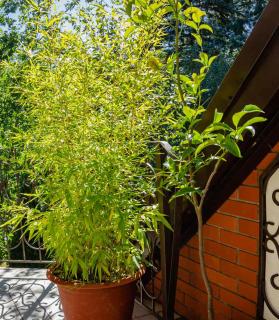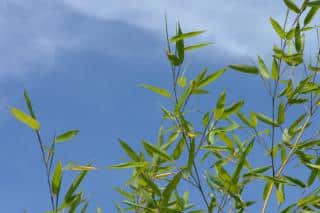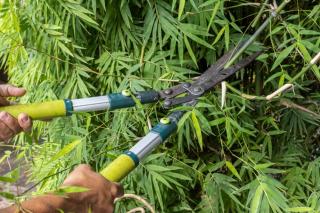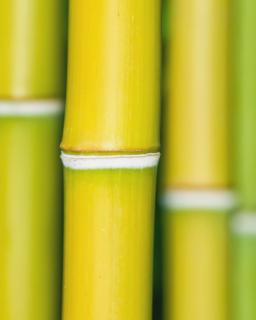

Bamboo is a beautiful modern evergreen shrub, but if left unchecked, it may spread uncontrollably.
Basic Bamboo facts
Name – Phyllostachys, Pleioblastus…
Family – Poaceae
Type – bamboo
Height – 6 to 60 feet (2 to 20 m)
Exposure: full/part sun – Soil: normal – Foliage: evergreen
Our advice for planting, care and trimming should help you grow beautiful bamboo.
The planting of a bamboo is an important step because it influences root growth and bamboo development.
Plant bamboo preferably in fall but, it can also take place in spring as long as you water regularly at the beginning.
Other than that, avoid planting bamboo during frost spells or heat waves.
To avoid bamboo invading your entire garden, set up a root or rhizome barrier.
Useful: video on planting and controlling bamboo
Bamboo grows fast and usually survives both drought and freezing very easily.
At the beginning, growth is a bit slow: rhizomes are developing underground and setting up the plant’s support system. The real growing starts 2 or 3 years after planting.
If you’d prefer a dwarf bamboo variety that will always stay a small, reasonable size, opt for Pleioblastus.
 The golden rule for planting a bamboo in a pot is to make sure watering is easy. You’ll need to water as soon as the surface soil is dry.
The golden rule for planting a bamboo in a pot is to make sure watering is easy. You’ll need to water as soon as the surface soil is dry.
Regular watering of potted bamboo is crucial. When soil dries up, roots in pots lack water and bamboo needs lots of it.
The best time to multiply bamboo is during the spring.
 Bamboo is an easy plant to care for, as long as you’ve properly set up your rhizome barrier.
Bamboo is an easy plant to care for, as long as you’ve properly set up your rhizome barrier.
Once in place, bamboo requires little care and can be trimmed at will.
Bamboo needs lots of water, especially in containers. It’s important that the soil doesn’t stay dry for very long between 2 watering sessions.
Adding fertilizer is important for bamboos, especially for potted bamboos.
The best bamboo fertilizers must contain high levels of nitrogen. It is best to choose bamboo fertilizer or even basic lawn fertilizer since bamboo is actually a member of the grass family.
 Height is yours to decide, and you may choose how high to let it grow without any dire consequence.
Height is yours to decide, and you may choose how high to let it grow without any dire consequence.
It will not only allow for your bamboo to hold well, it will also increase the density of stems in the clump.
Note that a trimmed stem won’t grow back. However, new culms will sprout at the base of the clump.
Do you want a fast and tall-growing bamboo species? Go for Phyllostachys, such as Phyllostachys nigra or Phyllostachys aurea.
One of the bamboo varieties common in temperate zones is Pseudosasa japonica, also called Japanese Arrow Bamboo. It boasts large leaves and reaches heights of 16 to 17 feet (4 to 5 m), and loses its leaves from the bottom up as years go by.
 Although it resists most diseases, bamboo is rather vulnerable to several species of insects and parasites.
Although it resists most diseases, bamboo is rather vulnerable to several species of insects and parasites.
Bamboo resists nearly all diseases, but it might start getting yellow leaves.
Aphids might appear. They are often harmless for bamboos, unless they invade in large numbers.
Bamboos are also vulnerable to scale insect attacks. Leaves develop a whitish accumulation, turn yellow and eventually fall off.
Finally, red spider mites can be seen sucking the sap from bamboos, leading to yellowing leaves that eventually fall off.
 Bamboo comes from Asia where it is a well-known commodity, used also to feed panda bears for which it is a staple food.
Bamboo comes from Asia where it is a well-known commodity, used also to feed panda bears for which it is a staple food.
It was first found in China, then in Japan, but now it grows in many gardens.
Today, many different varieties are used for evergreen hedges, and also in pots or garden boxes on terraces and balconies.
Choose bamboo if you wish to hide yourself from your neighbor’s view in short time while adding an exotic touch to your garden.